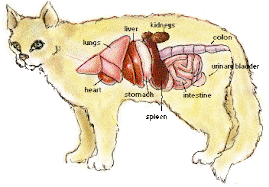Cat allergy is by far the commonest allergy to pet animals and up to 40% of asthmatics are sensitive to cats. The cat allergen is much more likely to cause sensitisation than that of the dog.
The Cat Allergen
A tiny protein particle, the "Fel d 1" allergen is found mainly in the cat skin flakes and saliva. The protein is produced in the cat salivary glands and sebaceous glands of the skin. Cats are fastidious groomers, so they deposit the Fel d 1 protein on their fur by licking themselves.
An allergen is a material, which is capable of provoking an allergic reaction, such as pollen grain, dust mite or animal dander. Cat allergen — the allergy causing material from cats - is not cat hair but a protein present in the dander and saliva of cats. The allergens become airborne as microscopic particles, which when inhaled into the nose or lungs, can produce allergic symptoms.
Although individual cats may produce more or less allergen, there is no relationship between the pet’s hair length and allergen production, and no such thing as a non-allergic breed.
Male cats are more allergic than female cats, because testerone increases Fel d 1 production by the sebaceous glands.
Where is Cat Allergen found?
Cat allergen is present in largest amounts in homes with cats, but has also been found in homes where cats have never been present and in offices or public spaces where animals are not allowed. Cat allergen is particularly sticky and is carried on clothing from places with cats to other locations. It is almost impossible to not be exposed to some level of cat allergen. Of course, levels of exposure will be much higher where cats are present, and these levels are more likely to cause allergic symptoms.
Because cat allergen particles are particularly small (1/10 the size of dust mite allergen), they remain airborne for prolonged periods of time. Cat allergic individuals are more likely to have a rapid onset of symptoms when entering a room with cats, because there is always allergen, which is airborne and can be easily inhaled. Opening windows, using exhaust fans and using high efficiency air cleaners, can decrease the amount of airborne allergen.
Soft furnishings, such as carpets, sofas and mattresses, will hold cat allergen even after a cat has been removed from the home or banished from the bedroom. It has been shown that it can take as long as 20 weeks for levels of allergen in carpets to decrease to levels found in a home without a cat, and up to 5 years for cat allergen levels in mattresses to decrease to such levels. Removal or treatment of the carpet or sofa, and encasing of the mattress, will reduce the continued exposure to these reservoirs of allergen.
Cat allergen is also found on vertical surfaces such as walls. Attempts to decrease cat allergen exposure in a home should include wall cleaning. If the cat is removed to a restricted area of the home, it is important to realise that airflow through the duct system in a hot air heated home could spread the allergen. Efficient vent and furnace filters could help trap the allergens and reduce the spread. READ MORE:http://www.allergyclinic.co.nz/guides/7.html
































 Custom
Custom 

